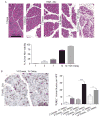Dendritic cells promote pancreatic viability in mice with acute pancreatitis
- PMID: 21801698
- PMCID: PMC3202684
- DOI: 10.1053/j.gastro.2011.07.033
Dendritic cells promote pancreatic viability in mice with acute pancreatitis
Abstract
Background & aims: The cellular mediators of acute pancreatitis are incompletely understood. Dendritic cells (DCs) can promote or suppress inflammation, depending on their subtype and context. We investigated the roles of DC in development of acute pancreatitis.
Methods: Acute pancreatitis was induced in CD11c.DTR mice using caerulein or L-arginine; DCs were depleted by administration of diphtheria toxin. Survival was analyzed using Kaplan-Meier method.
Results: Numbers of major histocompatibility complex II(+)CD11c(+) DCs increased 100-fold in pancreata of mice with acute pancreatitis to account for nearly 15% of intrapancreatic leukocytes. Intrapancreatic DCs acquired a distinct immune phenotype in mice with acute pancreatitis; they expressed higher levels of major histocompatibility complex II and CD86 and increased production of interleukin-6, membrane cofactor protein-1, and tumor necrosis factor-α. However, rather than inducing an organ-destructive inflammatory process, DCs were required for pancreatic viability; the exocrine pancreas died in mice that were depleted of DCs and challenged with caerulein or L-arginine. All mice with pancreatitis that were depleted of DCs died from acinar cell death within 4 days. Depletion of DCs from mice with pancreatitis resulted in neutrophil infiltration and increased levels of systemic markers of inflammation. However, the organ necrosis associated with depletion of DCs did not require infiltrating neutrophils, activation of nuclear factor-κB, or signaling by mitogen-activated protein kinase or tumor necrosis factor-α.
Conclusions: DCs are required for pancreatic viability in mice with acute pancreatitis and might protect organs against cell stress.
Copyright © 2011 AGA Institute. Published by Elsevier Inc. All rights reserved.
Figures







Similar articles
-
Intracellular Hmgb1 inhibits inflammatory nucleosome release and limits acute pancreatitis in mice.Gastroenterology. 2014 Apr;146(4):1097-107. doi: 10.1053/j.gastro.2013.12.015. Epub 2013 Dec 17. Gastroenterology. 2014. PMID: 24361123 Free PMC article.
-
CCL2-induced migration and SOCS3-mediated activation of macrophages are involved in cerulein-induced pancreatitis in mice.Gastroenterology. 2012 Apr;142(4):1010-1020.e9. doi: 10.1053/j.gastro.2011.12.054. Epub 2012 Jan 13. Gastroenterology. 2012. PMID: 22248664
-
Neutrophil Extracellular Traps Induce Trypsin Activation, Inflammation, and Tissue Damage in Mice With Severe Acute Pancreatitis.Gastroenterology. 2015 Dec;149(7):1920-1931.e8. doi: 10.1053/j.gastro.2015.08.026. Epub 2015 Aug 22. Gastroenterology. 2015. PMID: 26302488
-
Severe acute pancreatitis and reduced acinar cell apoptosis in the exocrine pancreas of mice deficient for the Cx32 gene.Gastroenterology. 2003 Feb;124(2):481-93. doi: 10.1053/gast.2003.50052. Gastroenterology. 2003. PMID: 12557153
-
TLR9 and the NLRP3 inflammasome link acinar cell death with inflammation in acute pancreatitis.Gastroenterology. 2011 Jul;141(1):358-69. doi: 10.1053/j.gastro.2011.03.041. Epub 2011 Mar 24. Gastroenterology. 2011. PMID: 21439959 Free PMC article.
Cited by
-
Redefining Immune Dynamics in Acute Pancreatitis: The Protective Role of Galectin-3 Deletion and Treg Cell Enhancement.Biomolecules. 2024 May 30;14(6):642. doi: 10.3390/biom14060642. Biomolecules. 2024. PMID: 38927046 Free PMC article.
-
Bmi1 is required for regeneration of the exocrine pancreas in mice.Gastroenterology. 2012 Sep;143(3):821-831.e2. doi: 10.1053/j.gastro.2012.05.009. Epub 2012 May 17. Gastroenterology. 2012. PMID: 22609312 Free PMC article.
-
Toll-like receptor 7 regulates pancreatic carcinogenesis in mice and humans.J Clin Invest. 2012 Nov;122(11):4118-29. doi: 10.1172/JCI63606. J Clin Invest. 2012. PMID: 23023703 Free PMC article.
-
Dendritic Cell Paucity Leads to Dysfunctional Immune Surveillance in Pancreatic Cancer.Cancer Cell. 2020 Mar 16;37(3):289-307.e9. doi: 10.1016/j.ccell.2020.02.008. Cancer Cell. 2020. PMID: 32183949 Free PMC article.
-
Autophagy, Inflammation, and Immune Dysfunction in the Pathogenesis of Pancreatitis.Gastroenterology. 2017 Nov;153(5):1212-1226. doi: 10.1053/j.gastro.2017.08.071. Epub 2017 Sep 14. Gastroenterology. 2017. PMID: 28918190 Free PMC article. Review.
References
-
- Fagenholz PJ, Fernandez-del Castillo C, Harris NS, et al. Direct medical costs of acute pancreatitis hospitalizations in the United States. Pancreas. 2007;35:302–7. - PubMed
-
- Bradley EL, 3rd, Dexter ND. Management of severe acute pancreatitis: a surgical odyssey. Ann Surg. 2010;251:6–17. - PubMed
-
- Willemer S, Elsasser HP, Adler G. Hormone-induced pancreatitis. Eur Surg Res. 1992;24 1:29–39. - PubMed
-
- Glasbrenner B, Adler G. Pathophysiology of acute pancreatitis. Hepatogastroenterology. 1993;40:517–21. - PubMed
Publication types
MeSH terms
Substances
Grants and funding
LinkOut - more resources
Full Text Sources
Medical
Research Materials

